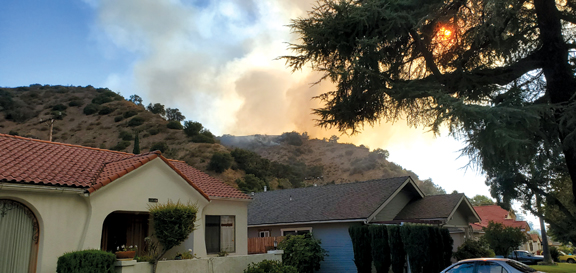The Colorado Fire stirs memories of the Station Fire of 10 years ago and reminds residents of just how deadly wildfires can be.

Smoke from fire burning on a nearby hillside clouded the skies above neighborhoods in Eagle Rock and Glenoaks Canyon.
By Mary O’KEEFE
On Sunday the all-too-familiar smell of smoke from a wildfire filled the air. It was about 4 p.m. when the Los Angeles Fire Dept. responded to a brush fire in the 2900 block of West Colorado Boulevard in Eagle Rock. The fire was titled the Colorado Fire.
When firefighters arrived they found one acre of brush burning between the transition roads of the Glendale (2) Freeway and the Ventura (134) Freeway.
“While firefighters worked to get a water supply established on the freeway, the wind picked up embers and carried them across to north of the 134 Freeway creating a new spot fire. Additional resources were immediately requested and the incident quickly grew to a major emergency status,” stated an LAFD release.
The transition at the 134 and 2 freeways was closed while firefighters continued to battle the blaze that continued to spread. LAFD, Glendale, Angeles National Forest and LA County fire departments assisted. Three LAFD helicopters, the LA City-contracted Erickson Air Crane and two helicopters from LACoFD made continuous water drops as fire crews worked on the ground.
Homes in the Glenoaks Canyon area were evacuated on Sunday afternoon but the order was lifted later that night. As of Tuesday, the fire was 100% contained with 45 acres burned. The cause of the fire remains under investigation.
The Colorado Fire is a reminder that fire season is here and residents need to be proactive regarding fire safety.
Fire season begins when summer temperatures dry out vegetation and, in Southern California, when the Santa Ana winds kick up in the fall, making fires even more active.
“The biggest thing [residents can do] when getting into fire season with the Santa Ana winds [coming] is to clean up things next to your house,” said Bat. Chief Rob Gaylord, LACoFD Station 82.
He added that cleaning up loose leaves and rain gutters go a long way to help harden a house against fire.
Winds provide an additional concern. When there are winds embers can travel several miles. Whether a house is at the base of a forested area, like Angeles National Forest, or several miles down from the mountain clearing property of dried vegetation and shrubs is important.
Gaylord said the Santa Rosa Fire of 2017 and the Panorama Fire of 1980 are two examples of how Santa Ana winds can change the course of a wildfire.
“Just because you are a few blocks away [from the forest] doesn’t mean you are immune from wildfires,” he said.
He suggests residents take time to walk around their homes to see what could be a possible hazard, like shrubs and what firefighters call ladder fuels – live or dried vegetation that fire can climb up, like low hanging tree limbs.
Even though July was the hottest on record for the entire Earth, there have been fewer wildfires to date than last year, but Gaylord reminds residents to not get lulled into a false sense of safety.
“We are about two to three weeks behind season average,” he said, “[but] fire season is starting now.”
